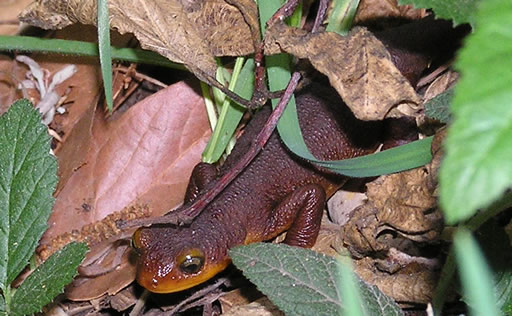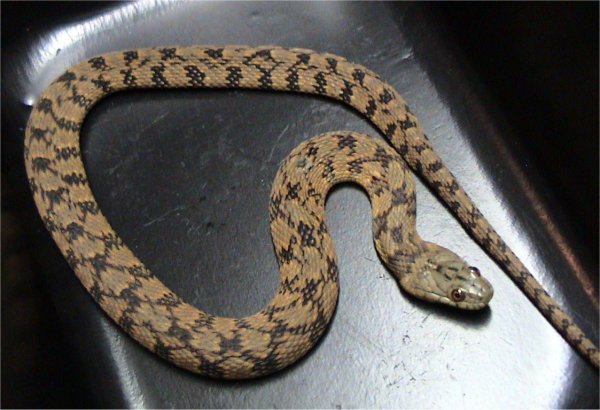Please see Part I of this article for information on our prepared box turtle diets.
Natural Food Animals
 Live mealworms, waxworms or earthworms mixed into canned or pelleted food should encourage your turtle to take a bite. Earthworms are a box turtle favorite and a highly nutritious food in their own right…they can comprise 25% or so of the diet. An occasional pre-killed pink mouse is usually a great hit with box turtles, but is not a necessity.
Live mealworms, waxworms or earthworms mixed into canned or pelleted food should encourage your turtle to take a bite. Earthworms are a box turtle favorite and a highly nutritious food in their own right…they can comprise 25% or so of the diet. An occasional pre-killed pink mouse is usually a great hit with box turtles, but is not a necessity.
Canned Snails and Insects
Canned insects and invertebrates offer an excellent means of increasing dietary variety while adding to the attractiveness of commercial turtle foods. Box turtles avidly consume snails and slugs in the wild…canned snails are nearly always well-accepted by pets. Canned silkworms, grasshoppers, crickets and mealworms should also be offered.
Fruits and Vegetables
Commercial diets should also be supplemented with a wide variety of fruits and vegetables, including apples, pears, berries of all kinds (berries are a favorite, but should form only a part of your pet’s salad), cucumbers, carrots, mushrooms and others. Sweet potatoes are usually a favorite. Avoid bananas, as turtles often eat these to the exclusion of all else, and they are not a natural food item.
Vitamins, Minerals and UVB Light
A vitamin/mineral supplement should be provided once weekly for adults, three times weekly for youngsters.
Box turtles should always be provided with a source of UVB radiation (via a fluorescent or mercury vapor bulb ) so that they can properly utilize the calcium that is contained in their diets. Please see my article on Reptisun UVB lamps for further information.
Wood turtles can be fed as described above; although some individuals can be picky feeders, they tend to accept a wider range of foods than do most box turtles.
Further Reading
Please see my article Providing a Balanced Diet to Reptile and Amphibian Pets for further information on reptile and amphibian nutrition.
You can read about ongoing field research projects involving box and wood turtles in the Northeastern USA at http://www.turtleconservationproject.org/projects.html.
 That Reptile Blog – Reptile, Amphibian and Exotic Pet Care and Information
That Reptile Blog – Reptile, Amphibian and Exotic Pet Care and Information

 Over 200 compounds, some of which are medically significant, have been isolated from newt and salamander skins. Western North America’s rough-skinned newt (Taricha granulosa) possesses what may very well be the salamander world’s most powerful secretions…a single adult packs enough to kill 25,000 mice. More than one person (usually male, drunk and involved in some sort of “initiation” or dare), has suffered fatal consequences after swallowing a rough-skinned newt.
Over 200 compounds, some of which are medically significant, have been isolated from newt and salamander skins. Western North America’s rough-skinned newt (Taricha granulosa) possesses what may very well be the salamander world’s most powerful secretions…a single adult packs enough to kill 25,000 mice. More than one person (usually male, drunk and involved in some sort of “initiation” or dare), has suffered fatal consequences after swallowing a rough-skinned newt. Although the California newt’s (Taricha torosa) toxins pale in comparison to those of its rough-skinned cousin, they are not to be trifled with. I kept a California newt with an American eel for 17 years. The eel, a voracious predator that would as soon latch onto my hand as anything else, never once molested its seemingly defenseless tank-mate.
Although the California newt’s (Taricha torosa) toxins pale in comparison to those of its rough-skinned cousin, they are not to be trifled with. I kept a California newt with an American eel for 17 years. The eel, a voracious predator that would as soon latch onto my hand as anything else, never once molested its seemingly defenseless tank-mate. Background color varies through shades of pale gray to dark brown, with reddish to black cross-bands. Juveniles are brightly marked, while the colors of older animals usually darken. Stoutly built, the northern watersnake may reach 4 ½ feet in length, but averages 3 feet.This species interbreeds with its subspecies, the midland water snake, which may confuse identification at range overlaps.
Background color varies through shades of pale gray to dark brown, with reddish to black cross-bands. Juveniles are brightly marked, while the colors of older animals usually darken. Stoutly built, the northern watersnake may reach 4 ½ feet in length, but averages 3 feet.This species interbreeds with its subspecies, the midland water snake, which may confuse identification at range overlaps. This snake can build up large populations in suitable habitat but, in my experience, does not adjust well to human presence (it is sometimes killed in the mistaken belief that it is venomous and reduces game fish numbers).
This snake can build up large populations in suitable habitat but, in my experience, does not adjust well to human presence (it is sometimes killed in the mistaken belief that it is venomous and reduces game fish numbers). Well, we’ve come a long way since the anole “sugar water days” (the recommended diet for green anoles sold at circuses in the 1960’s). Following is a mix that I and others have found useful for anoles, geckos, basilisks, skinks and others.
Well, we’ve come a long way since the anole “sugar water days” (the recommended diet for green anoles sold at circuses in the 1960’s). Following is a mix that I and others have found useful for anoles, geckos, basilisks, skinks and others.